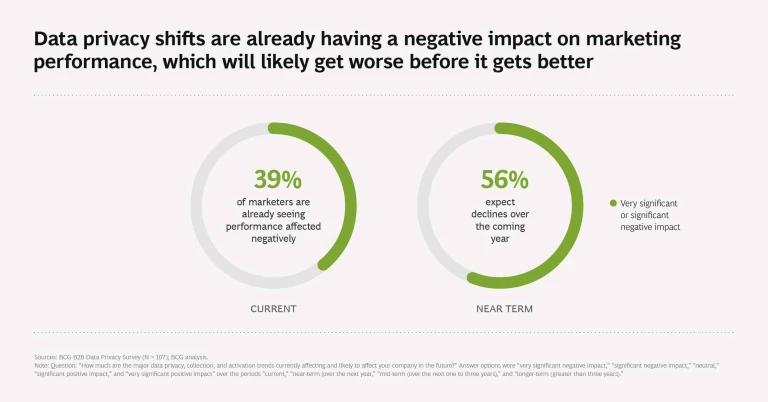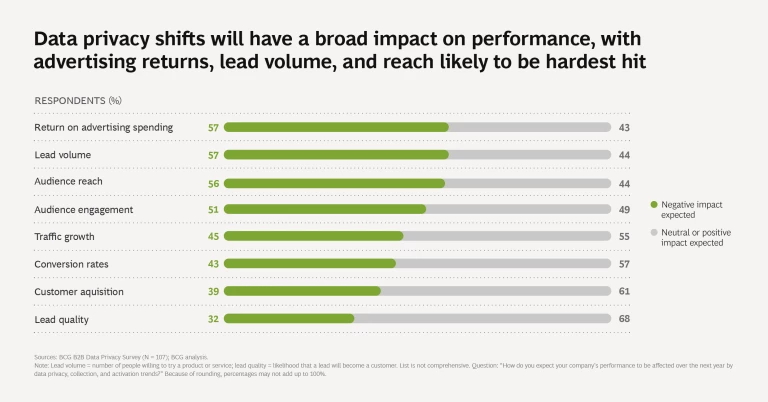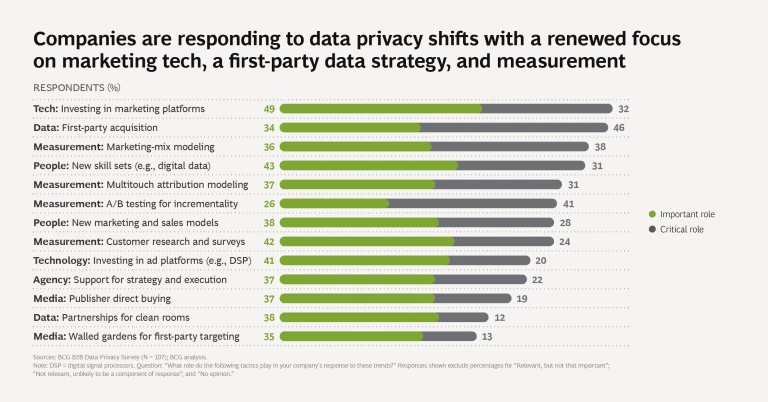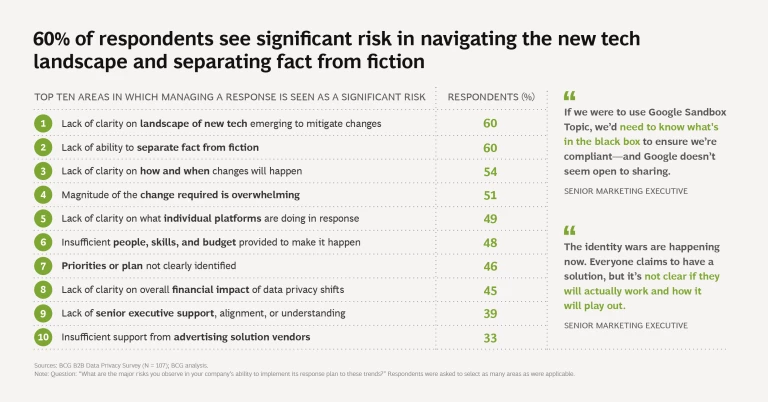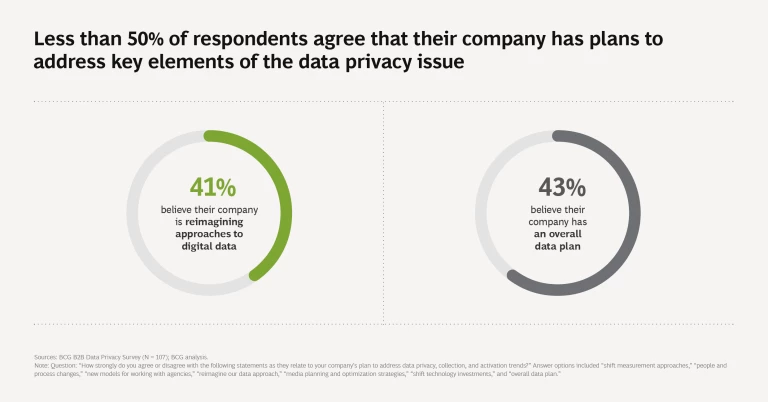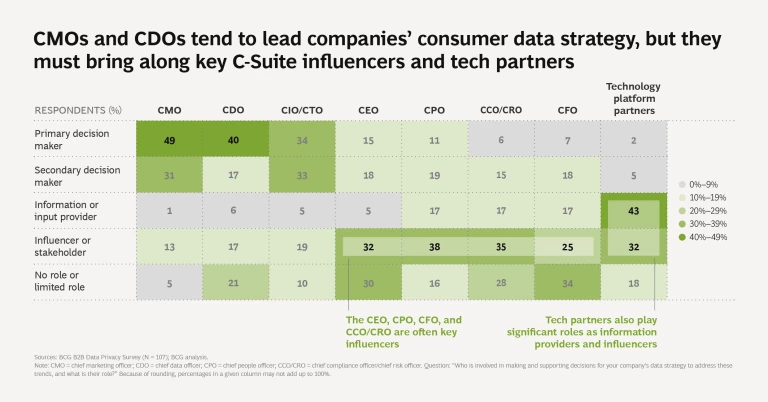Faced with stricter government regulation of third-party customer data sharing and beefed-up privacy features in new operating systems and browsers, digital marketers must rethink their data strategies.
B2B marketers’ ability to acquire and use customer data is changing dramatically. Legislative data protections are growing, Apple has introduced new privacy features in iOS 14, and Google intends to eliminate internet cookies from its Chrome browser.
Yet marketers require customer data and identifiers for their digital marketing campaigns and inbound and outbound sales. A lack of such information could harm their company’s growth potential. In a recent survey by BCG and LinkedIn, 39% of marketers said that they were already seeing a negative impact on their marketing performance from the changes, and 56% expected to see detrimental impact over the coming year. (See “Our Survey Methodology.”)
Our Survey Methodology
We asked marketers in the survey to self-categorize as data rich (having access to first-person data from customers), data regulated (having access to first-person data from customers within structural limits, such as in the health care and financial services industries), or data challenged (having limited access to first-person data).
Our purpose was to gain a broader understanding of business perspectives on data privacy, collection, and activation trends and of companies’ responses to those trends.
Making matters worse, less than 50% of our respondents said that their companies had made coordinated plans to adapt their customer-data strategy. In addition, a majority expressed confusion about the newly emerging technology landscape, the timing of the shift, and the actions they should take in response.
Although the ultimate marketing landscape and solutions may be unclear, marketers should not wait for clarity before advancing their own capabilities. Instead, they should start looking immediately for ways to overcome the loss of third-party data access. First, they should seek new ways to gather and use first-party data. Second, they should invest in specific technologies to differentiate capabilities with the right account-based engagement (ABE) systems , which coordinate outreach to all client contacts. Third, they should initiate sweeping efforts to attract, retain, and train the necessary digital talent.
Companies that delay will find their tardiness costly. In our experience, mature marketing organizations have increased their sales by 18 percentage points, experienced 29 percentage-point gains in cost savings, and seen double the market-share growth of less-mature organizations. B2B marketers are expected to boost their marketing spending by 10% to 15% a year for the next five years, so the financial benefits they may derive from accelerating their capability building are enormous. Businesses that wish to build sustained competitive advantage in a world without cookies need to act now.
A Sea Change Is Here
Companies that successfully acquire and use insights into customer needs can realize tremendous benefits—targeting their marketing in a precise and customized way, supporting critical inbound and outbound go-to-market activities, improving customer experiences, and fueling revenue growth.
A number of impending changes will significantly affect all elements of digital marketing —targeting, optimization, reporting, and measurement—and it is critical for marketers to understand what they are. For one thing, regulatory changes are limiting how companies can store, use, and sell data. And for another, platform policy changes from leading tech companies—in particular, Apple and Google—are hurting competition between platforms and strengthening incumbents as they jostle for competitive position.
Legislative Changes. New US legislation designed to protect consumer privacy is pending. This legislation follows on the heels of the California Consumer Privacy Act, which took effect in early 2020, and the 2018 General Data Protection Regulation in Europe, the world’s toughest privacy law, recently bolstered by an Austrian Data Protection Authority decision stating that Google Analytics violates the legislation. Both laws limit how companies can use and sell data, give consumers more information about the data that businesses collect, and give consumers the right to opt out of the sale of that data. Governments in other regions are bound to follow suit.
“We are already starting to see 30% declines in clicks for the same budget, so will start to shift budgets across partners, even as we continue testing.” —CMO of an enterprise tech company
Apple iOS. With its rollout of iOS 14.5, Apple introduced the AppTrackingTransparency framework, which gives consumers the option of limiting access to identifiers for advertisers (IDFAs)—device identifiers that Apple assigns to each user’s phone to enable advertisers to track app downloads and usage and deliver cross-device marketing communications.
Under this framework, advertisers must ask users for permission to track them across apps and websites owned by other companies. This type of tracking has traditionally been used for advertising purposes, and allowing consumers to opt out of it will clearly reduce advertisers’ ability to target and measure their campaigns. Similar restrictions on IDFAs in Google’s ecosystems, including Android devices, may appear in the future.
Cookie Deprecation. Apple’s Safari and Mozilla’s Firefox browsers have already eliminated third-party cookies, and Google has announced that it will deprecate third-party cookies from Chrome by 2023 (recently pushed back from 2022)—a significant change, given that the Chrome browser’s global market share exceeds 60%. A multitude of potential solutions may replace cookies or mitigate their loss, such as The Trade Desk’s UID 2.0 and Google’s Topics, which clusters people into groups with similar interests in order to protect their individual privacy.
Our Marketing Survey
To gain a broad understanding of the business perspective on these changes, we surveyed more than 100 senior marketing and IT executives across B2B and B2B2C businesses and B2C business models in North America and conducted interviews with 20 of those executives.
We found that marketers, in aggregate, think that these changes are rapidly chipping away at their effectiveness. In fact, more than half of those surveyed—62%—believe that at least one-fifth of their data for targeted marketing is at risk. This risk is particularly acute for companies marketing to small-to-medium businesses. (See the slideshow.)
Although the changes will cut across all industries, they will affect different marketers in different ways. Marketers whose companies tend to have a lot of data, such as e-commerce-led business models that collect transaction and purchasing data, do not expect to be affected to the same extent as others.
In contrast, those working in fields that lack their own transaction data (for example, B2B2B or B2B2C models), anticipate that they will be harder hit as a result of losing access to a great deal of available third-party data. In response, they will have to shift strategically to acquiring first-party data, determining its value, and using it to optimize their marketing efforts and outcomes.
Finally, marketers whose businesses work with regulated data, such as those in financial services and health care sectors, will be subject to closer scrutiny and heavier restrictions than others in their handling of the data they gather. But regardless of which category their business falls into, it is imperative for marketers to brace for the future.
Confusion and Concern Abound
Our survey also revealed that while marketers recognize that data-privacy changes are a critical issue, most are struggling to navigate the shifts. In fact, 60% of our respondents registered a lack of clarity on the landscape of new technologies emerging to mitigate the negative effects of regulatory changes that address data privacy, collection, and activation issues, making it difficult for them to separate fact from fiction. In addition, 54% were unclear about how and when data privacy, collection, and activation policies would change—to the extent that many marketers are focusing either on Apple’s iOS and Google’s third-party cookie deprecation or on legislative changes, depending largely on their business model.
It also became apparent in our discussions with B2B marketers that although they understand the importance of addressing the challenges emerging along the end-to-end marketing value chain—from planning to activation to measurement—most do not yet have a robust plan of action in place. Many are in the early stages of responding and have not yet begun to navigate the technological, cross-functional, and change-management complexity coming down the road. There is no shortage of new solutions on offer in this space, but parsing out what can truly add value is a challenge, and many marketers are looking for more support from partners, including technology vendors.
Many B2B marketers in our research expressed not only uncertainty and confusion about the changes, but also more specific concerns about their own ability to handle and measure the new landscape and to hire the talent for it.
“Going forward, we expect to see a decrease in targeting effectiveness of 15% to 30%.” —VP of marketing at a US financial services institution
Inadequate Technology Stack. Interestingly, one of the most common themes we found in our research was marketers’ concern that, even if they gain access to the necessary data, their underlying marketing technology stack will be unable to catalog, store, and use the data in line with increasingly stringent data-privacy regulations. More than three-quarters of our survey respondents named this as their greatest challenge. In particular, they expressed concern about having the necessary account-based marketing (ABM) or ABE systems and accompanying customer-data platforms (CDP).
Measurement Challenges. Another leading concern involved measuring the true impact of marketing efforts. Our respondents wondered whether common metrics and targets would hold up in the future world of identifiers. When working with large accounts, they may find that their growing reliance on first-party data will help them track specific customers and improve their measurement of customer responses. In many B2B contexts, however, tracking and measuring accounts in the “long tail” will create tremendous challenges. Attribution systems tied to cookies will naturally be threatened, and using marketing-mix models may cause difficulties for B2B marketers (as it has in the past), given the fact that B2B purchasing cycles often exceed six months.
Talent Gaps. Survey respondents also cited attracting, retaining, and training the necessary digital talent as a key challenge. Finding suitable talent is a perennial issue, but it is particularly acute here, given the general lack of available expertise in digital advertising fundamentals, not to mention the need to manage the customer data-and-identifier changes coming down the road. Such expertise will be essential not only for marketing in a cookieless world, but for realizing the full benefits of AI and automation, which will be increasingly important to marketing success in the future. Moreover, this talent gap persists across both senior- and junior-level teams at organizations. In fact, nearly three-quarters of those surveyed highlighted their teams’ need to develop new skills in data, analytics, and technology if the business is to realize its full potential.
Given the number of challenges, any solution must be multipronged. However, companies that invest in a multipronged response should see huge benefits.
Create a Plan—and Put It into Action
Responding appropriately to changes that are coming from all angles in real time is critical. In that context, marketers need to develop strategies that can hold up under many possible scenarios. We therefore recommend the following seven timeless actions. These do not depend on any specific shift, but instead optimize the business’s entire marketing approach.
Invest in first-party data. Marketers have relied heavily on the cookie. In fact, for many of them, the cookie became a crutch. Now B2B marketers must find new ways to acquire, maintain, and use first-party proprietary data—information that only the marketer and the company could possibly know about their customers—to create value for both the business and the customer.
For instance, some SaaS tech vendors offer promotional credits in exchange for a customer’s contact information. And some health care businesses combine first-party data with AI-based approaches to determine the best timing and content for outreach to customers and to provide better treatment options. One health care leader improved its ROI by more than 30% by increasing its use of first-party data and advanced analytics to inform its outbound marketing. Its heightened use of first-party data came in direct response to the deprecation of value from third-party data.
“I feel like I’m trying to build a house on quicksand with all of the changes to data privacy.” —CMO of a small-to-medium US software company
To optimize this approach, marketers should determine the value of each type of data they want and the cost of acquiring it, so that they can prioritize their investments. They should then unify each customer’s data into a single ID and build out a 360-degree customer model that looks at all customer touch points. We recommend working through a clean room (a secure data environment) and using other protections to safeguard data and ensure that the company maintains customers’ privacy and trust.
Build advanced analytics—and use them wisely. New analytical capabilities can accelerate and improve the use of first-, second-, and third-party data. However, marketers should not rely entirely on algorithms. Because modern marketers have access to historically unavailable data, they are in a position to offer a unique combination of customer data and business knowledge, generating better outcomes than algorithms alone can deliver. In addition, they can and should inform all parts of the marketing, sales, and product value chain with real-time data feeds and decision making.
For example, an industrials business employed advanced analytics and AI to market to customers solely on the basis of contextual first-party data such as customer location, season, and past purchases. This information, uniquely known to the company and independent of the limits on identifiers and internet cookies, enabled the business to target very specific customer segments and increase its ROI by 20%.
Create partnerships. Marketers should look for opportunities to create a mutual value exchange with partners in order to accelerate data capture. For instance, they should boost their partnerships with second-party data providers and secure clean-room environments. And they should work closely with platforms that have useful data for influencing their target audiences or can support qualified lead generation.
When a financial- and HR-services leader expanded its mix of data partners to include social media platforms, it found that it could create new lead generation at half of the previous cost. By emphasizing early and frequent interaction between marketing leadership and IT, legal, and compliance teams, it accomplished this is a privacy-friendly way.
Evolve measurement and attribution. Marketers can create value by building measurement tools that are independent of privacy-restricted data and instead measure the incremental business impact of their marketing efforts. This approach will move them away from traditional digital measurement tools that rely excessively on cookies and identifiers, such as last-touch attribution and multitouch attribution models. In their place, marketers can develop a more integrated toolkit that triangulates value across multiple dimensions. The tools will accelerate the use of marketing experiments, such as matched-market methodologies (which enable users to measure changes in business outcomes in different markets in response to changes in marketing treatments) and advanced marketing-mix models that employ granular customer insights and marketing activity data to predict business outcomes.
One enterprise technology business increased its use of ABM solutions by using advanced AI to reconfigure its lead scoring (the way it ranked the sales readiness of each lead). This allowed the company to improve its routing of incoming marketing-qualified leads across digital representatives, account executives, and nurture-based campaigns (using extended outreach to grow the customer relationship). As a result, its pass rate from marketing-qualified to sales-qualified lead improved by 100%.
Reduce risk in technology investments, and focus on durability. Today’s tectonic shifts offer a unique moment for marketers and technology leaders to assess their existing technology stack and evaluate the parts that are resilient to future privacy changes and add value for customers. As they do so, they should acknowledge the uncertain future of technology that relies on cookies, such as data-management platforms, multitouch attribution tools, and retargeting platforms, and assess other offerings, such as contextual targeting.
They should also assess the current slate of MarTech and AdTech vendors for durability and be wary of new, potentially unsustainable innovations such as fingerprinting technology. And they should ensure that their approach to assessing prospective third-party vendors includes a risk assessment of the future viability of their technologies in an enhanced-privacy and cookieless world.
Achieve cross-functional agreement. Now is not the time to build a solution in a marketing bubble. Marketers must coordinate their plans with the C-suite. A successful plan requires significant cross-functional input from the CMO and other C-level executives, with the CMO, in particular, playing an essential role in creating a bridge between collecting consumer data and maintaining consumer trust. In addition, businesses must hire and train employees with the analytic capabilities and skill sets necessary to execute the new data-driven strategies.
Advance collaborative learning. Businesses should support and accelerate collaborative learning across the C-suite through internal teams and trusted partners, creating a shared knowledge base on the fundamentals of the data opportunity. Participants should work together to establish a cross-functional team to evaluate available technology, launch pilots to assess new partners and identity solutions, and research potential big bets, such as on new technologies for data collection and storage, new data-capture strategies, or third-party vendor partnerships. And they should set technology and data acceleration as regular topics at C-level leadership meetings.
Marketers are faced not only with great risks to avoid, but also with tremendous value to be gained in finding and implementing an optimal response to this new data environment. Those who invest in a first-party data strategy, adopt advanced analytics, create essential new partnerships, evolve their measurement tools and technology stack, build cross-functional teams, and generate collaborative learning will have no regrets as the sea change in data privacy continues.


